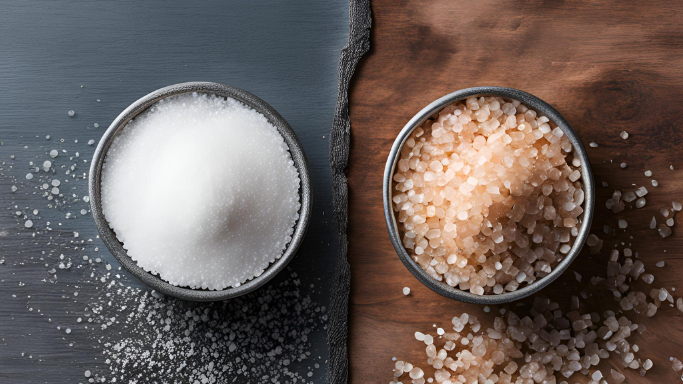Salt is a staple in nearly every kitchen around the world. Whether it’s enhancing the flavor of a dish or preserving food, salt plays a vital role in cooking. Among the most commonly used types are table salt and sea salt. While both serve the same purpose, their origins, production processes, textures, and flavors differ. In this article, we’ll explore the distinctions between sea salt and table salt and discuss when each is best used.
1. Source and Production Process
The primary difference between sea salt and table salt lies in their source and production process.
Table Salt is mined from underground salt deposits, which are remnants of ancient seas that evaporated long ago. The salt is then refined to remove impurities and trace minerals. During the refining process, additives such as iodine and anti-caking agents are often added to improve shelf life and prevent clumping. This gives table salt its fine, uniform texture and bright white color.
Sea Salt, on the other hand, is harvested through the evaporation of seawater. The process is more natural, with seawater being collected in shallow pools and left to evaporate under the sun and wind. This method allows sea salt to retain its natural minerals and elements found in the water. As a result, sea salt comes in a variety of textures and colors, depending on the location it’s harvested from and the minerals present in the water.
2. Texture and Grain Size
-
Table Salt is finely ground, which gives it a smooth texture and allows it to dissolve quickly. This makes it ideal for recipes where salt needs to be evenly distributed, such as in baked goods or liquid-based dishes.
-
Sea Salt, by contrast, has a coarser texture and comes in larger crystals or flakes. These crystals may vary in size depending on the brand or region. Some types of sea salt, like fleur de sel, are particularly delicate and flaky, while others may be chunkier. Its larger, irregular crystals make sea salt a popular choice for finishing dishes, as it adds a pleasant crunch and burst of flavor.
3. Flavor and Mineral Content
-
Table Salt primarily consists of sodium chloride (NaCl) and has a sharp, pure salty taste. Because it’s highly refined, it lacks many of the natural minerals found in seawater. Some table salts are iodized, meaning they contain added iodine to help prevent iodine deficiency, which can lead to thyroid issues.
Sea Salt retains more of the natural minerals from the seawater it’s harvested from, such as magnesium, calcium, and potassium. These minerals not only contribute to sea salt’s unique flavor but also give it a more complex and often less harsh taste compared to table salt. Depending on the location it’s sourced from, sea salt can have a slightly bitter, sweet, or briny flavor profile, making it a favorite among chefs and food enthusiasts.
4. Health Considerations
While both sea salt and table salt are composed primarily of sodium chloride, the minerals in sea salt may offer additional health benefits. For example, magnesium found in some types of sea salt is believed to help with muscle function and hydration, while potassium can support heart health. However, the differences in mineral content are minimal, and both salts are still high in sodium, which can contribute to high blood pressure if consumed in large amounts.
Table salt is often iodized, which can help prevent iodine deficiency—a concern in some parts of the world where iodine-rich foods are scarce. Iodine is essential for thyroid function and overall health, and its addition to table salt is considered a major public health success.
5. Culinary Uses
Table Salt is perfect for everyday use in cooking and baking. Its fine, uniform grains make it easy to mix into doughs, batters, and sauces. It dissolves quickly and evenly, making it ideal for recipes that require precise measurements and even distribution of salt.
Sea Salt is typically used as a finishing salt, sprinkled on food just before serving to add flavor and texture. Its larger crystals or flakes provide a satisfying crunch and enhance the overall eating experience. Sea salt is often used on roasted meats, vegetables, salads, and even desserts like chocolate or caramel. Additionally, its more complex flavor can add nuance to dishes that benefit from a bit of extra seasoning at the end of cooking.
Conclusion
Although both sea salt and table salt serve the same basic purpose in the kitchen, they differ in their texture, flavor, and mineral content. Table salt, highly refined and often iodized, is perfect for everyday cooking and baking, while sea salt’s larger crystals and complex flavor make it ideal as a finishing touch for dishes. Whether you choose one over the other ultimately depends on personal preference and how you plan to use it in your cooking. Both salts can enhance the flavor of your food, but the method of extraction and the minerals they retain give each its own unique characteristics.




